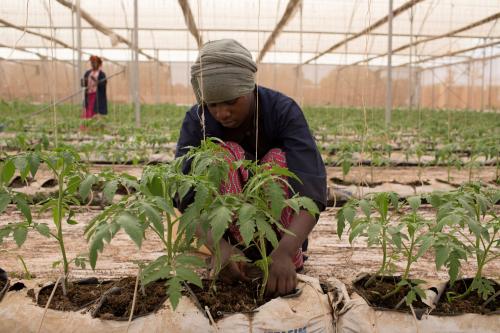While Africa is home to about 60 percent of the world’s available arable land, many African countries are among the most affected globally by food insecurity and low agricultural productivity. In 2014-2015, 153 million people over 15 years of age suffered from severe food insecurity in sub-Saharan Africa (about 26 percent of the given population, compared to 7.5 percent of world average). In 2016, more than 55 million of children under the age of five suffered from stunting and 14 million, wasting. Moreover, sub-Saharan African children under the age of five are 14 times likely to die than in developed countries.
Though CAADP struggled early on, it has not been a total failure.
At its launch, Comprehensive Africa Agriculture Development Programme (CAADP) proposed that African countries allocate 10 percent of their total annual budgets toward boosting agricultural productivity. But six years after its launch, only 13 countries had signed the CAADP compact (Benin, Burundi, Cape Verde, Ethiopia, The Gambia, Ghana, Liberia, Mali, Niger, Nigeria, Rwanda, Sierra Leone, and Togo).
In fact, CAADP had numerous procedural milestones for participant countries. Each country interested in joining CAADP is required to engage in preparation and signing of the CAADP compact; a joint commitment by stakeholders; draft and complete a technical review of the National Agriculture and Food Security Investment Plans (NAFSIPs); convene a business meeting in which stakeholders could endorse and commit to funding; and finally implement the program, including monitoring and updating it. Even among those countries that signed the compact early on, only a limited number had really used the program’s resources to develop their agricultural policies.
A 2010 report from NEPAD noted that the “CAADP’s biggest disappointments have been its failure to secure greater understanding and ownership of CAADP at country level, and to not achieve more in terms of increased investment in the sector by governments and development partners.” The CAADP Secretariat also recognized a difficult beginning, considering especially that its resources have not measured up to its ambitions, admitting that it “has not been provided with the human or financial resources or legal status to enable it to fulfill its mandate and role.”
On the other hand, CAADP has now hit its stride: While most African countries have not achieved CAADP goals, some countries have made more progress than others, especially the most committed and diligent ones, such as Ghana. As of November 2016, at least 42 countries had signed the CAADP’s compact, and a few additional ones were working towards signing it. Now three-quarters of African countries are now committed. In addition, at least 40 have developed a National Agricultural Investment Plan, presenting agriculture as a top priority.
Policy commitment and perseverance at the national and regional levels, as well as international support, have helped turn CAADP’s difficult beginning into implementation progress in numerous countries, some of the most notable ones including Benin, Burkina Faso, Burundi, Côte d’Ivoire, Ethiopia, Ghana, Kenya, Liberia, and Malawi. They are increasingly prioritizing agriculture and food security as a national-level driver of economic growth. The United Nations Office of the Special Adviser on Africa even noted in 2015 that “average public agricultural expenditures have risen by more than 7 percent per year across Africa since 2003, nearly doubling public agricultural expenditures since the launch of CAADP.” True, we are still far from the initial goals of 10 percent of national budget allocation and 6 percent growth rate in agricultural productivity, and countries are struggling to fund their National Agriculture and Food Security Investment Plan, but many countries are moving forward toward the right direction.
In this way, I believe that some programs (such as CAADP) can be ineffective in the short run, but bring about more important transformations in the long run (a point I argue in my recent book, Innovating Development Strategies in Africa: The Role of International, Regional, and National Actors).
Process-compliant early adopters have, on average, outperformed laggards.
Notably, it seems that the countries that signed the CAADP compact earlier and the countries that are more advanced in CAADP implementation outperform the others, even if not systematically. A report co-edited by Covic Namuko and Sheryl Hendriks provides these insights on CAADP performance. Their comparison of the evolution of the share of agriculture in total public expenditure (percent) during the pre- and post-CAADP launch periods based on the level of implementation by 2015 shows that a broad—but not homogenous—progression of the annual average. This is the case in Benin, Ethiopia, and Ghana, for example. However, none of the categories (early adopters or laggards) has reached the target of 10 percent of resources allocated to agriculture, even if a few countries were individually able to do so. Moreover, the countries that have not signed the CAADP continue to under perform. Although agricultural productivity has increased during the periods of 1993 to 2003 and 2003 to 2008, neither the early adopters nor laggards have reached CAADP’s goal of improving agricultural productivity to the annual average growth rate of 6 percent. Thus, despite disparities, the overall better performers are also the earlier CAADP signatories and more advanced implementers. Moreover, overall performance has slightly decreased for the period 2008 to 2015, compared to the two prior periods.
It is necessary to create an enforcing mechanism and better ownership.
CAADP has developed a plan to sustain its momentum. This plan tries to address past coordination challenges and create higher levels of national ownership and accountability. However, processes remain voluntary and lack enforcement. Therefore, despite the broad adoption of its compact and a handful of success stories, the true impact of CAADP on transforming agriculture—beyond contributing to shared continental norms related to its importance and incremental improvements of performance indicators—remains to be seen. This is especially true when the tangible indicators identified by CAADP itself are used to measure progress: Agricultural growth remains weak, and several countries have suffered repeated food crises. Too many member states that adopt the new vision and policies do not necessarily implement them. Moving forward, policymakers should ensure sufficient coordination, accountability, and compliance, as well as successful resource mobilization to boost agricultural productivity and address food insecurity. Concretely:
Countries are ultimately responsible for CAADP’s successful implementation.
- Policymakers should take better ownership of CAADP and translate their commitments into action, instead of using CAADP process as a simple tool to mobilize external resources. Studies have shown that some outperformers such as Ethiopia and Rwanda were countries that have strong domestic political incentives to invest in agriculture, as well as serious political commitment at the highest level, with heads of state or government sympathetic to the pan African vision, the Maputo Declaration and CAADP processes (Ghana and Rwanda). For them, agriculture is considered by these countries a stronger strategy to generate growth, reduce food insecurity and alleviate poverty, and, in some instances, ensure political control. A strategy to increase ownership and accountability could also be to seriously involve constituents and various shareholders in the formulation and implementation process and ensure the dissemination of progress to the broader public.
- Policymakers should mobilize domestic resources and find innovative sources of finance (in order to avoid dependency toward fluctuating external capital flows) and invest them toward agricultural productivity and food security. Agricultural productivity could be increased by the development of infrastructures to facilitate market access, the optimization of land, water, and resource management, agricultural research, and stimulation of the private sector to unleash productive investments in the sector. Intentional policies should be developed to ensure food availability, accessibility, and appropriate utilization both qualitatively and quantitatively to prevent malnutrition.
- Policymakers should ensure sufficient coordination, alignment, and compliance among implementing actors and agencies. This is critical for providing adequate and timely resource allocation and management as well as effective management of environmental vulnerability and shock mitigation. In so doing, they should be learning from the most successful experiences (such as Ghana) and create a conducive environment for economic freedom, investment, and private enterprises.
Continental and regional institutions such as CAADP, NEPAD, the African Union, and the regional economic communities (RECs) should continue to play and important role, moving toward more constraining enforcement mechanisms.
- RECs have already played a major role by facilitating the adoption of CAADP by their member states: Economic Community of West African States (ECOWAS) for Burkina Faso and Ghana, and Common Market for Eastern and Southern Africa (COMESA) for Kenya, for example. Moving forward, they should work to keep the momentum and address the barriers related to the delivery capacity and resources, while creating incentive for a renewed political will.
- CAADP, NEPAD, and the African Union should all bring all their weight to bear on implementation. They should play a key role in addressing shortcomings, mapping the root causes of country successes and failures in order to better define the levers that should be pushed to facilitate implementation. For example, they should be able to determine to which extent it is political will, delivery capacity, financial resources, or human capital that is affecting the level of implementation, and intervene accordingly in a more direct manner, and when necessary, in collaboration with the RECs and international actors. The legal framework for such intervention should be defined.
- Continental and regional institutions should finally channel resources from donors, and direct them to the most process-compliant and politically committed, societally inclusive, transparent, private-sector friendly, and accountable leaders.
The Brookings Institution is committed to quality, independence, and impact.
We are supported by a diverse array of funders. In line with our values and policies, each Brookings publication represents the sole views of its author(s).











Commentary
The quest for food security and agricultural transformation in Africa: Is the CAADP the answer?
October 16, 2017